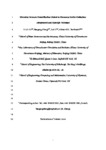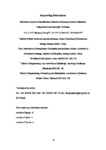Microbial selenate detoxification linked to elemental sulfur oxidation: Independent and synergic pathways
| dc.contributor.author | Li, L | |
| dc.contributor.author | Zhang, B | |
| dc.contributor.author | Li, L | |
| dc.contributor.author | Borthwick, Alistair | |
| dc.date.accessioned | 2021-11-09T19:11:13Z | |
| dc.date.issued | 2022-01 | |
| dc.identifier.issn | 0304-3894 | |
| dc.identifier.issn | 1873-3336 | |
| dc.identifier.other | 126932 | |
| dc.identifier.uri | http://hdl.handle.net/10026.1/18292 | |
| dc.description.abstract |
Elevated selenium levels in the environment, with soluble selenate [Se(VI)] as the common chemical species, pose a severe threat to human health. Anaerobic Se(VI) bioreduction is a promising approach for selenium detoxification, and various organic/inorganic electron donors have proved effective in supporting this bioprocess. Nevertheless, autotrophic Se(VI) bioreduction driven by solid inorganic electron donors is still not fully understood. This work is the first to employ elemental sulfur [S(0)] as electron donor to support Se(VI) bioreduction. A batch trial with mixed culture demonstrated the feasibility of this bioprocess, with Se(VI) removal efficiency of 92.4 ± 0.7% at an initial Se(VI) concentration of 10 mg/L within 36 h. Continuous column tests showed that increased initial concentration, flow rate, and introduction of NO3--N depressed Se(VI) removal. Se(VI) was mainly bioreduced to solid elemental Se with trace selenite in the effluent, while S(0) was oxidized to SO42-. Enrichment of Thiobacillus, Desulfurivibrio, and Sulfuricurvum combined with upregulation of genes serA, tatC, and soxB indicated Se(VI) bioreduction was coupled to S(0) oxidation. Thiobacillus performed S(0) oxidation and Se(VI) reduction independently. Intermediate metabolites as volatile fatty acids, hydrogen and methane from S(0) oxidation were utilized by heterotrophic Se(VI) reducers for Se(VI) detoxification, indicative of microbial synergy. | |
| dc.format.extent | 126932-126932 | |
| dc.format.medium | Print-Electronic | |
| dc.language | en | |
| dc.language.iso | en | |
| dc.publisher | Elsevier BV | |
| dc.subject | Biodetoxification | |
| dc.subject | Elemental sulfur | |
| dc.subject | Microbial reduction | |
| dc.subject | Selenate | |
| dc.subject | Humans | |
| dc.subject | Oxidation-Reduction | |
| dc.subject | Selenic Acid | |
| dc.subject | Selenious Acid | |
| dc.subject | Selenium | |
| dc.subject | Selenium Compounds | |
| dc.subject | Sulfur | |
| dc.title | Microbial selenate detoxification linked to elemental sulfur oxidation: Independent and synergic pathways | |
| dc.type | journal-article | |
| dc.type | Journal Article | |
| dc.type | Research Support, Non-U.S. Gov't | |
| plymouth.author-url | https://www.ncbi.nlm.nih.gov/pubmed/34419844 | |
| plymouth.volume | 422 | |
| plymouth.publication-status | Published | |
| plymouth.journal | Journal of Hazardous Materials | |
| dc.identifier.doi | 10.1016/j.jhazmat.2021.126932 | |
| plymouth.organisational-group | /Plymouth | |
| plymouth.organisational-group | /Plymouth/Faculty of Science and Engineering | |
| plymouth.organisational-group | /Plymouth/Faculty of Science and Engineering/School of Engineering, Computing and Mathematics | |
| plymouth.organisational-group | /Plymouth/Users by role | |
| plymouth.organisational-group | /Plymouth/Users by role/Academics | |
| dc.publisher.place | Netherlands | |
| dcterms.dateAccepted | 2021-08-15 | |
| dc.rights.embargodate | 2022-8-16 | |
| dc.identifier.eissn | 1873-3336 | |
| dc.rights.embargoperiod | Not known | |
| rioxxterms.versionofrecord | 10.1016/j.jhazmat.2021.126932 | |
| rioxxterms.licenseref.uri | http://www.rioxx.net/licenses/all-rights-reserved | |
| rioxxterms.licenseref.startdate | 2022-01 | |
| rioxxterms.type | Journal Article/Review |



